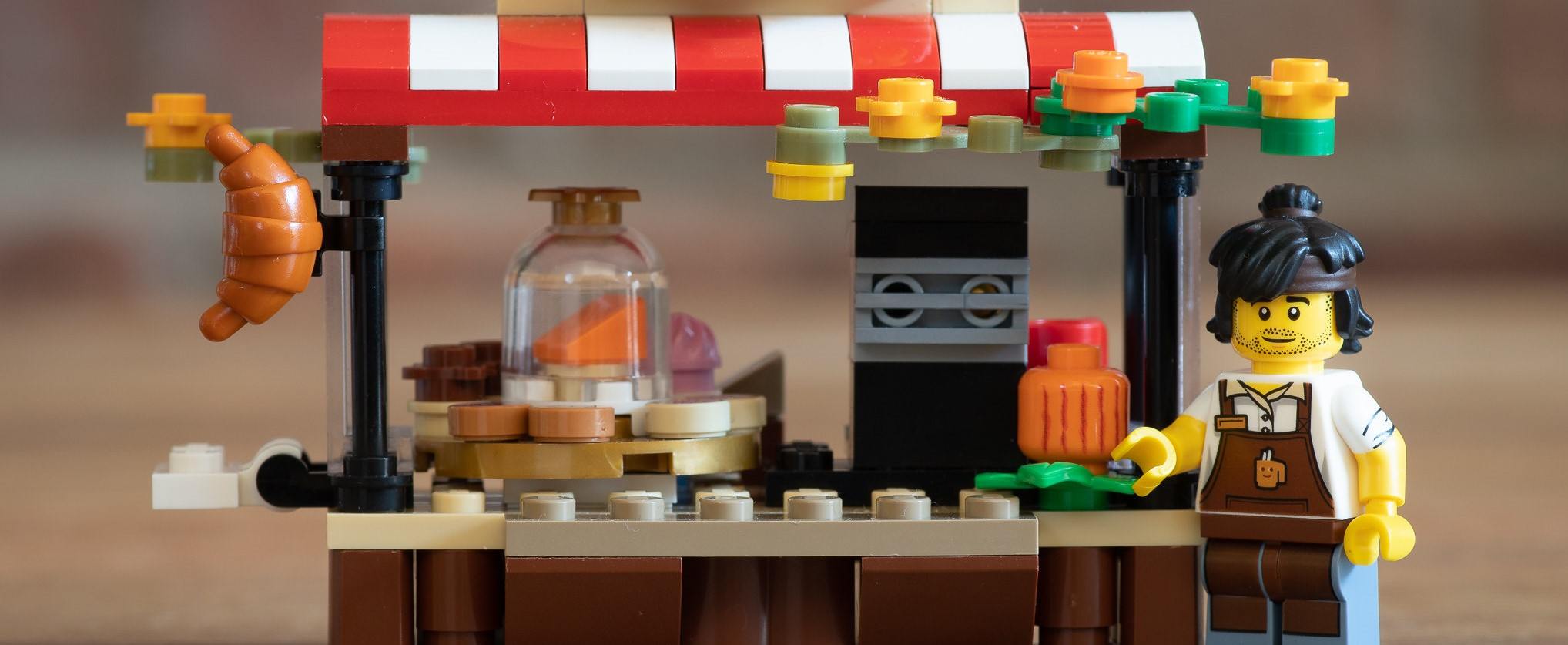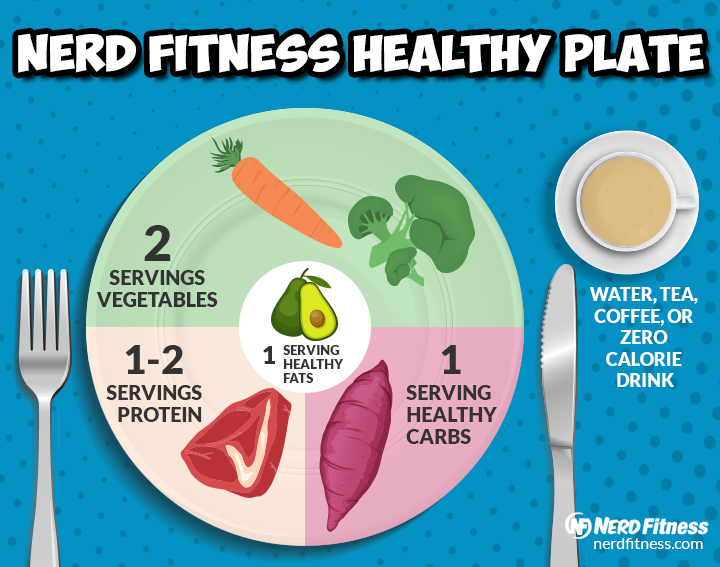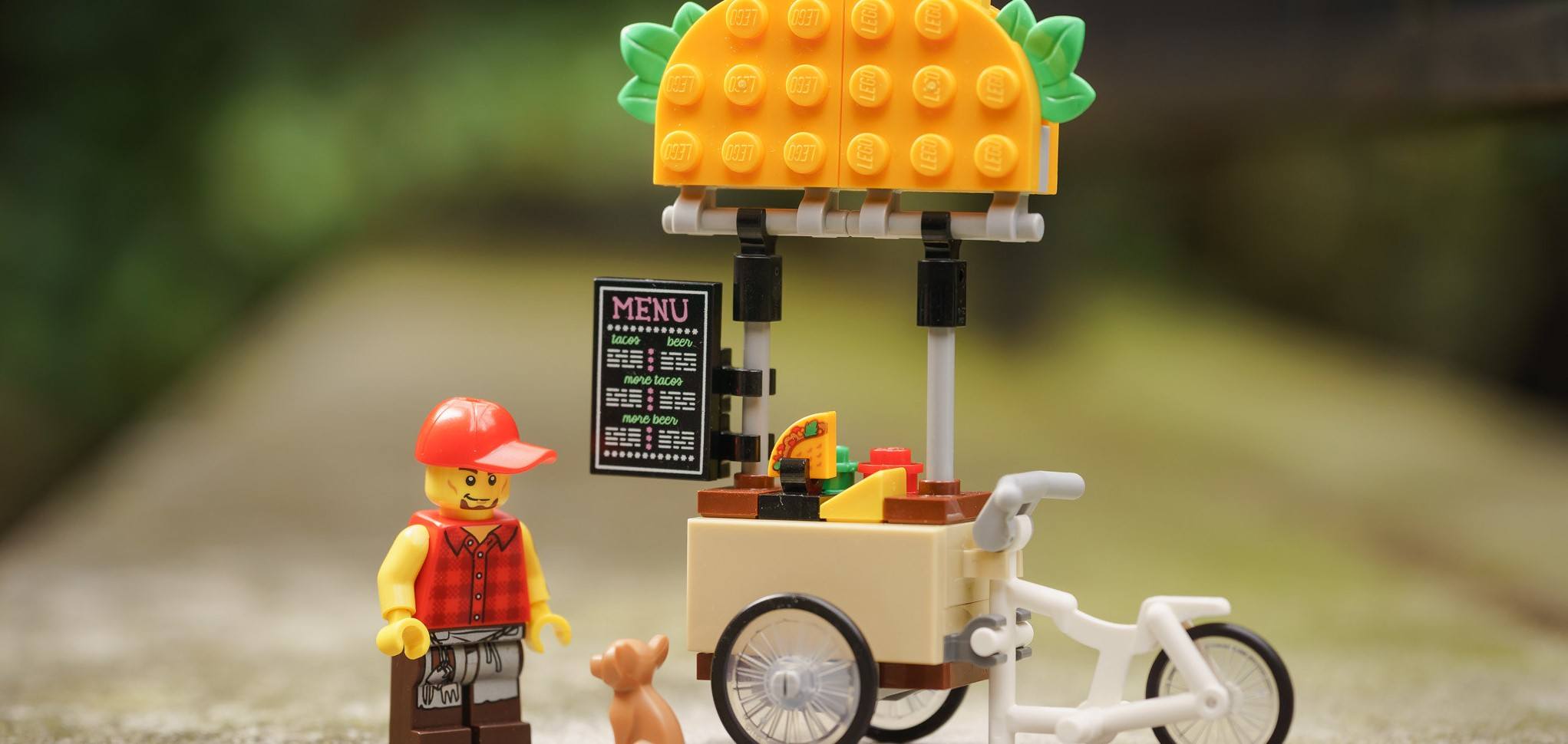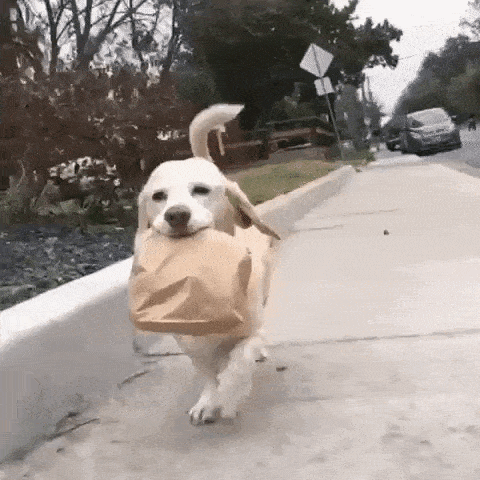Originally posted at: http://www.nerdfitness.com/

It’s time to learn how to portion control!
There are all sorts of “tips” and “tricks” out there, but today we’re going to show you the best method.
What makes me so confident?
For many of our Online Coaching clients, we create portion control strategies for weight loss that don’t suck. Today, we’ll share them with you too!
Here’s what we’ll cover:
- What are 5 methods for portion control?
- How to learn portion control (the best method)
- What is the Correct Portion Size Part 1: Protein and Vegetables
- What is the Correct Portion Size Part 2: Carbs and Fats
- How to use portion control containers and plates
- How to control portion sizes when eating out
- How to portion control for weight loss (Next steps)
Let’s do this thang!
What Are 5 Methods for Portion Control?

As you might know from our “How to lose weight” guide, the key to sustainable weight loss is getting ourselves to consume fewer calories in a way that doesn’t make us miserable.
Because our brains and bodies are complicated emotional disasters, there are some tips and tricks we can implement to protect us from…ourselves:
- Use smaller plates. Folks will often eat what’s placed in front of them, so using smaller dinnerware has been shown to help people eat less.[1]
- Drink a glass of water before your meal. If you chug a glass of water 30 minutes before you plan on eating, the H20 will take up some room in your stomach. This might help you eat less.[2]
- Take it slow. It can take about 20 minutes for your body to come around to the fact that it’s full, so slowing down your meals can help you eat less.[3]
- Use a food journal. Recording everything you eat and drink is a great way to become aware of portions, which can help you control them.[4] In fact, one of the first missions we have Nerd Fitness Prime members complete is creating a food journal.
All of these strategies will work to some extent, and they’re good to keep in mind and also practice.
However, nothing will get more consistent results than actually learning the number of calories in the food you eat (Portion Control Tip #5)!
This is our number one recommendation for how to lose weight.

Study[4] after study[5] after study[6] shows that our bodies obey the laws of thermodynamics and that in order to lose weight, we need to burn more calories than we consume regularly.
- When you consume more calories than you burn, your body tends to store those extra calories as fat (weight gain).
- When you burn more calories than you consume, your body will pull from fat stores for energy (weight loss).
However, as we point out in our Calories In, Calories Out guide, determining your exact “calories in” can be a real pain. Not only that, but many people with certain personality traits can become neurotic about tracking every single calorie, and worrying if they go 1 calorie over their daily allotment.
So, what’s a nerd to do?
Unless you’re going to weigh out all your food (something I’ve done before) and be militant about tracking, is it possible to “track” your food with a high level of accuracy without having it take over your life?
The answer: yes, by getting darn good at estimating!
Portion Sizes: How to Portion Control (The Best Method)

You already carry with you the best method for portion control.
Your hands!

We’re going to use them to build a healthy plate, as shown above.
The “Nerd Fitness Healthy Plate” was originally published in our Guide to Healthy Eating, which was inspired by our friends over at Precision Nutrition.
We’re not going to worry about being exact.
It’s really hard to be precise anyway.[7]
However, using your hands as a tool for portion control provides a “good enough” strategy that can help your food intake:

As you can see, we’re going to focus our portion control strategy on:
- Protein
- Vegetables (technically carbs, but important enough to deserve their own category)
- Carbohydrates (think starches and fruit)
- Fat
Each macronutrient will correspond to an area of your hand, to give you a sense of what a proper portion size should be.
We’ve learned that using your hand as a guide is the most helpful strategy for portion control:
- You might not always have access to small plates.
- You might forget to drink water before each meal.
- You might have a short lunch break without the luxury of eating slowly.
- You might grow tired of logging all your food intake.
However, having an intuitive sense of what foods should be eaten in what portions will help you level up your healthy eating.
When in doubt, match the food in front of you to your hand and carry on.
Let’s break this down a little by talking about protein and veggies.
What is the Correct Portion Size Part 1: Protein and Vegetables
The above video was live-streamed to Nerd Fitness Prime members, as part of our NF Kitchen series.
In it, Coach Lauren and Justin discuss the two most important parts of every meal: protein and vegetables.
Here’s something that might seem counterintuitive: our #1 recommendation for portion control isn’t about limiting food. Instead, make sure you get a proper serving of protein and vegetables every time you sit down to eat.
In other words, when you begin your healthy eating journey, don’t even worry about nixing any specific food. Just make sure you are leaving plenty of room for protein and vegetables.
A serving of protein is about the size and thickness of your palm:

Protein can come from any number of sources, including:
- Meat (steak, bison, pork).
- Fowl (chicken, turkey, duck).
- Eggs![8]
- Fish and shellfish (salmon, tuna, shrimp).
- Legumes (black beans, chickpeas).
Not a meat-eater? Read our massive plant-based guide!
A serving of veggies is about the size of your fist:

Here’s a quick, non-complete list of veggies that can fill half your plate:
- Broccoli
- Broccolini
- Cauliflower
- Spinach
- Kale
- Spaghetti squash
- Brussels sprouts
- Zucchini
- Cucumber
- Carrots
- Onion
- Asparagus
When it comes to learning portion control, start by making sure you eat enough protein and vegetables.
How much?
As we discuss in our protein guide, when building a plate aim for the following amount of protein:
- Dudes: 1-2 servings (6-8 oz or about 170-228 g): two palms
- Dudettes: 1 serving (3-4 oz or about 85-114 g): 1 palm.
For vegetables, in practice you can probably eat as much as you can stomach (the fiber will likely slow you down), but aim for about 2 fist fulls at most meals, or about half your plate.[9]
Don’t like veggies? I was once like you. Check out 10 ways to make vegetables taste good.
Here’s why you should prioritize protein and vegetables if you’re struggling with portion control:
- Protein. Eating enough protein will assist your health as you age.[10]Plenty of protein will also help you retain and grow muscle.[11] Plus, prioritizing protein will help you stay full and satiated between meals.[12]
- Vegetables. Veggies are both high in nutrients and low in calories, which makes them ideal for a healthy plate. Plus, the fiber will not only help your health, it’ll also keep your indoor plumbing in proper order.[13]
In the video that kicks off this section, Coach Justin makes a great point: aim for a little better than you are today.
Meaning if you don’t really plan your meals at all, start by having ONE meal include a good protein source and some veggies.

So maybe you make chicken stir-fry this week.
Once you have that win under your belt, you can aim for doing a little bit more next week (TWO meals that include protein and veggies).
We’ll close out today’s guide with some more ideas on how to get going.
Before we get there, we need to talk about what else can go into your healthy plate.
What is the Correct Portion Size Part 2: Carbs and Fats
After making room on your plate for protein and vegetables, what’s next?
As Coach Lauren and Justin mention in the Nerd Fitness Prime video above, it’s time to include some healthy carbohydrates and fats!
Depending on what fitness camp you find yourself in and your history of “dieting,” eating carbs and fats might make you nervous.
But as Coach Lauren points out, they have a purpose on our healthy plate! You just need to portion them out correctly.
A serving of carbohydrates is about two hands cupped together:

If it’s uncooked, it’s about half the size, so one cupped hand.
Examples of healthy carbohydrates:
- Brown rice or white rice
- Legumes, lentils
- Quinoa
- Potatoes
- Sweet potatoes
- Yams
- Pasta
- Whole grain bread
You also want to make sure you’re including healthy fat in your diet too.
Fat is actually the most calorically dense macronutrient, so comparatively it’ll take up less room on your hand.
Here is a serving of fat, roughly the size of your thumb!

Healthy fat can be found in foods like:
- Avocado
- Almonds
- Walnuts
- Macadamia nuts
- Olive oil
- Almond butter
- Peanut butter
The reason people call it “healthy” is because the fat is unsaturated, although science has recently come around on saturated fat too in the correct amounts.[14]
We cover this in detail in our Guide to the Keto Diet.
Saturated fats can come from things like:
- Whole milk
- Full fat dairy
- Coconut oil
- Grass-fed butter
- Lard
- Fatty cuts of meat
When it comes to portion control, we need to pay close attention to carbohydrates and fats, because this is where people have the tendency to overeat.
However, that doesn’t mean we want to completely ditch both food groups either.

Here’s why you need to eat these two macronutrients:
- Carbohydrates. Did you know fiber is a type of carbohydrate? Yep. As we mentioned earlier, you need plenty of fiber for good health.[15] Carbs are also a great source of quick energy, especially fruit.[16]
- Fats. Some nutrients like Vitamin A are fat-soluble, meaning they are best absorbed alongside some fat.[17]Fat will also help you feel full, which can help with overall portion control for the day.[18] While a little goes a long way, you wouldn’t want a “zero fat” diet.[19]
Just be careful here.
When we analyze the diets of our coaching clients who can’t seem to lose weight, it’s almost always because they are overeating carbs or fats.
If you find yourself in this group, take a look at your hand the next time you sit down to eat:
- How much pasta are you serving yourself? It should fit within your cupped hands.
- How much olive oil did you place on your salad? It should be about the size of your thumb or a tablespoon.
- How big is your serving of peanut butter, REALLY? One serving, a tablespoon, is about the size of a walnut:

Remember: you don’t have to get this perfect. You just need to be pretty good most of the time.
Even just consciously thinking about if your portion sizes are under or over is a great start.
And as long as you are consistent with your measuring techniques, then you can adjust your portions based on your progress!
You might also find some special plates or containers helpful when serving yourself.
How to Use Portion Control Containers and Plates
One hack Coach Justin uses is simple Tupperware containers to portion control his meals:

You can also use some glass containers too if you want to get fancy:

Don’t stress about finding the perfect container that exactly holds each macronutrient you need.
The point here is that you have a quick frame of reference for portion sizes:
- The largest portion of the container: vegetables go here.
- The two smaller portions: these are for your protein and carbs.
- The small little holder: your fats go here.
Again, don’t stress if your container doesn’t fit this description exactly. We’re all working off estimates here, so let’s focus on the big picture.
These are some cool glass containers if you’re looking for something to buy.
How to Control Portion Sizes When Eating Out

An area of concern when attempting to portion control is dining out.
It seems like restaurants serve you twice the amount of food that you need.
So do what Coach Justin does: ask for a to-go box as soon as you place your order.
Yeah, it’s a little weird, but as soon as you get your food, place half of it in the container.
Boom, an extra meal for later.

Another thing to consider: restaurants want you to leave feeling full.
They often do this by piling on the carbs. Think extra bread, lots of rice, plenty of pasta, etc.
So it might make sense to split these portions in two, and you’re set for lunch the next day.
Also, if you get hungry after eating only half your meal, no problem. Just eat the other half. Even if you’re still at the restaurant.
The point is to consciously think about how much you’re eating. A break half-way through can be used as a decision tree:
Should I keep eating?
This question alone can help with portion control.
One last thing: we know eating out at restaurants is often a family or friend bonding experience, so we’d prefer you ENJOY the night. Food is more than just calories.
Just plan for it! If you eat a really large dinner for a celebration, eat slightly smaller portions for the next day or so and your body will be right back on track.
How to Portion Control for Weight Loss (Next Steps)
In the video above, Coach Lauren and Justin walk you through eating a Nerd Fitness Healthy Plate IRL (In Real Life).
It’s all well and good to build a healthy plate at home, but what if you’re at a restaurant?
What if you need to order a sandwich?
How about pizza?
Here are some tips from the Coaches for portion control IRL:
#1) Sandwich
The trick here is to pack in as many vegetables as you can. Yeah, you’re probably not going to get two fist fulls in, but you can squeeze in a lot of spinach, onion, sauerkraut, and tomato (yeah, it’s technically a fruit, whatevs) on your sandwich.
- Your carbs can be some type of whole grain bread (you can do an open face sandwich if you want to limit this).
- Your protein can come from some turkey.
- Your fat can be a little avocado.

Boom.
You now have a turkey sandwich that matches our healthy plate strategy.
#2) Chili/Soup
This can be a little tougher when everything is mixed together.
If you’re making it yourself, perhaps you measure out your hand portions as you cook.
- Put a palm-size portion of ground beef in.
- Your vegetables can be onion, garlic, and tomatoes (again a fruit, but who cares).
- Your carbs can be pinto and/or kidney beans.
- Your fat can be a little bit of cheese sprinkled on top.
Sure, maybe you’re doing less than two fistfuls of vegetables, and more than a cupped hand of carbs (beans).
It doesn’t matter. Again, the point is you’re putting a little thought into proper portions.
If you’re eating out and ordering soup or chili, maybe just think of the end product in mind:
“After portioning everything out, it should be about two fistfuls of food. So that’s what I’ll eat. Everything else I’ll take home.”
#3) Pizza
This is a little trickier because pizza is mostly bread (carbs).
But Coach Justin has a solution for this.
First, he eats something he’s proud of, like a salad.
Then he portions out his pizza, which if he uses his hand strategy, would be about two slices:

Is it perfect?
Nope.
Does it help Coach Justin reach his goals and allow him to still enjoy life?
Yep!
So experiment a little by creating some rough guidelines, see how you feel, and course-correct as you go.
Remember, any step you take on leveling up your nutrition is great.

If you don’t know where to start, I actually recommend you begin by not worrying about what to take OFF your plate, but instead what to add!
Make sure every meal you eat has a healthy protein source and a vegetable. Once you have that dialed in, THEN you can worry about portion controlling your carbs and fat.
If you need help along the way, we got you.
Here are three ways to continue your journey with Nerd Fitness.
#1) Liked the video we showed in today’s guide? Want to watch more like them live and get your questions answered? Join Nerd Fitness Prime!
Nerd Fitness Prime is our premium membership program that contains live-streamed workouts with NF Coaches, a supportive online community (with many like-minded people dealing with “portion control”), group challenges, and much more!
#2) Our Online Coaching program: a coaching program for busy people to help them make better food choices, stay accountable, and get healthier, permanently.
As I said before, we teach portion control to our clients who struggle with overeating, so we’ll provide a non-judgmental expert to help you reach your goals.
You can schedule a free call with our team so we can get to know you and see if our coaching program is right for you:
Option #3) Join the Rebellion! We need good people like you in our community, the Nerd Fitness Rebellion.
Sign up in the box below to enlist and get our Rebel Starter Kit, which includes all of our “work out at home” guides, the Nerd Fitness Diet Cheat Sheet, and much more!
- The 15 mistakes you don’t want to make.
- Full guide to the most effective diet and why it works.
- Complete and track your first workout today, no gym required.
Alright, I want to hear from you:
Do you have any tips or tricks for portion control?
Do you use the hand strategy that we covered today?
What’s your biggest challenge with portion sizes?
Let us know in the comments!
-Steve
PS: If you’re just starting your weight loss journey, make sure you check out:
###
Photo Source: Fresh lobster rolls, bean-there-donut-that-40358-2, Taco trike, Peanut/Walnut
- Read, “Bottomless Bowls: Why Visual Cues of Portion Size May Influence Intake.” Source, PubMed.
- Read, “Water Consumption Increases Weight Loss During a Hypocaloric Diet Intervention in Middle-Aged and Older Adults.” Source, PubMed.
- Read, “Eating Slowly Led to Decreases in Energy Intake Within Meals in Healthy Women.” Source, PubMed.
- This study found that those who keep a food diary lost more weight than those who didn’t.
- Like this study on sustainable weight loss
- Or this one on an energy deficit and weight loss.
- Or this one on weight loss predictions based on calorie intake and patient lifestyle.
- Read, “Calorie Estimation in Adults Differing in Body Weight Class and Weight Loss Status.” Source, PubMed.
- Dietary cholesterol doesn’t influence blood cholesterol levels as much as conventional wisdom once thought. Go ahead and eat eggs!
- Or about 2 cups.
- Read, “Role of Dietary Protein in the Sarcopenia of Aging.” Source, PubMed.
- Read, “Dietary Protein and Muscle Mass: Translating Science to Application and Health Benefit.” Source, PubMed.
- Read, “Protein, weight management, and satiety.” Source, Oxford Academic.
- Read this study on fiber and health and this one on fiber and the digestive tract.
- Read, “Saturated Fat: Part of a Healthy Diet.” Source, PubMed.
- Read, “Effects of Dietary Fiber and Its Components on Metabolic Health.” Source, PubMed.
- Read, “Carbohydrates as a Source of Energy.” Source, PubMed.
- Read, “Diet and Health: Implications for Reducing Chronic Disease Risk.” Source, PubMed.
- Read, “Optimising foods for satiety.” Source, ScienceDirect.
- WiseGEEK took an interesting look at “Rabbit Starvation,” which happens on a diet devoid of fat.
Filed under: Fitness


 For now classes are 6pm and 640pm at 2840 Wildwood st in the Boise Cloggers studio.
Book your class NOW!
click this ==>
For now classes are 6pm and 640pm at 2840 Wildwood st in the Boise Cloggers studio.
Book your class NOW!
click this ==>








